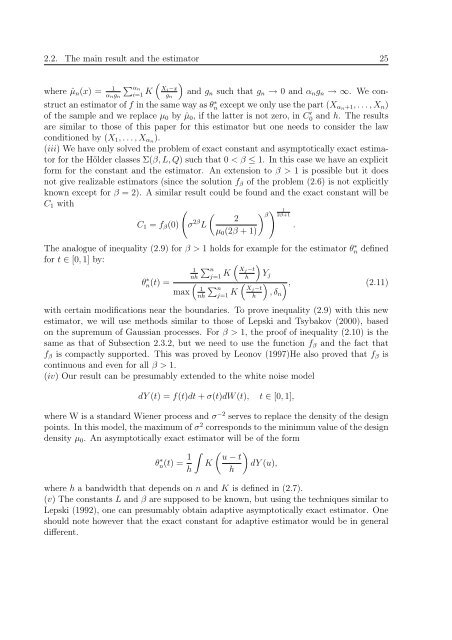THÈSE DE DOCTORAT DE L'UNIVERSITÉ PARIS 6 Spécialité ...
THÈSE DE DOCTORAT DE L'UNIVERSITÉ PARIS 6 Spécialité ...
THÈSE DE DOCTORAT DE L'UNIVERSITÉ PARIS 6 Spécialité ...
- No tags were found...
You also want an ePaper? Increase the reach of your titles
YUMPU automatically turns print PDFs into web optimized ePapers that Google loves.
2.2. The main result and the estimator 25∑ ( )where ˆµ n (x) = 1 αnα ng n i=1 K X i −xg nand g n such that g n → 0 and α n g n → ∞. We constructan estimator of f in the same way as θn ∗ except we only use the part (X αn+1, . . . , X n )of the sample and we replace µ 0 by ˆµ 0 , if the latter is not zero, in C 0 ′ and h. The resultsare similar to those of this paper for this estimator but one needs to consider the lawconditioned by (X 1 , . . . , X αn ).(iii) We have only solved the problem of exact constant and asymptotically exact estimatorfor the Hölder classes Σ(β, L, Q) such that 0 < β ≤ 1. In this case we have an explicitform for the constant and the estimator. An extension to β > 1 is possible but it doesnot give realizable estimators (since the solution f β of the problem (2.6) is not explicitlyknown except for β = 2). A similar result could be found and the exact constant will beC 1 with( (C 1 = f β (0) σ 2β Lθ ∗ n(t) =2µ 0 (2β + 1)) β) 12β+1.The analogue of inequality (2.9) for β > 1 holds for example for the estimator θn ∗ definedfor t ∈ [0, 1] by:∑ ( )1 nnh j=1 K Xj −tYh j(max1nh∑ nj=1 K (Xj −th), δ n), (2.11)with certain modifications near the boundaries. To prove inequality (2.9) with this newestimator, we will use methods similar to those of Lepski and Tsybakov (2000), basedon the supremum of Gaussian processes. For β > 1, the proof of inequality (2.10) is thesame as that of Subsection 2.3.2, but we need to use the function f β and the fact thatf β is compactly supported. This was proved by Leonov (1997)He also proved that f β iscontinuous and even for all β > 1.(iv) Our result can be presumably extended to the white noise modeldY (t) = f(t)dt + σ(t)dW (t), t ∈ [0, 1],where W is a standard Wiener process and σ −2 serves to replace the density of the designpoints. In this model, the maximum of σ 2 corresponds to the minimum value of the designdensity µ 0 . An asymptotically exact estimator will be of the formθn(t) ∗ = 1 ∫ ( ) u − tK dY (u),h hwhere h a bandwidth that depends on n and K is defined in (2.7).(v) The constants L and β are supposed to be known, but using the techniques similar toLepski (1992), one can presumably obtain adaptive asymptotically exact estimator. Oneshould note however that the exact constant for adaptive estimator would be in generaldifferent.










